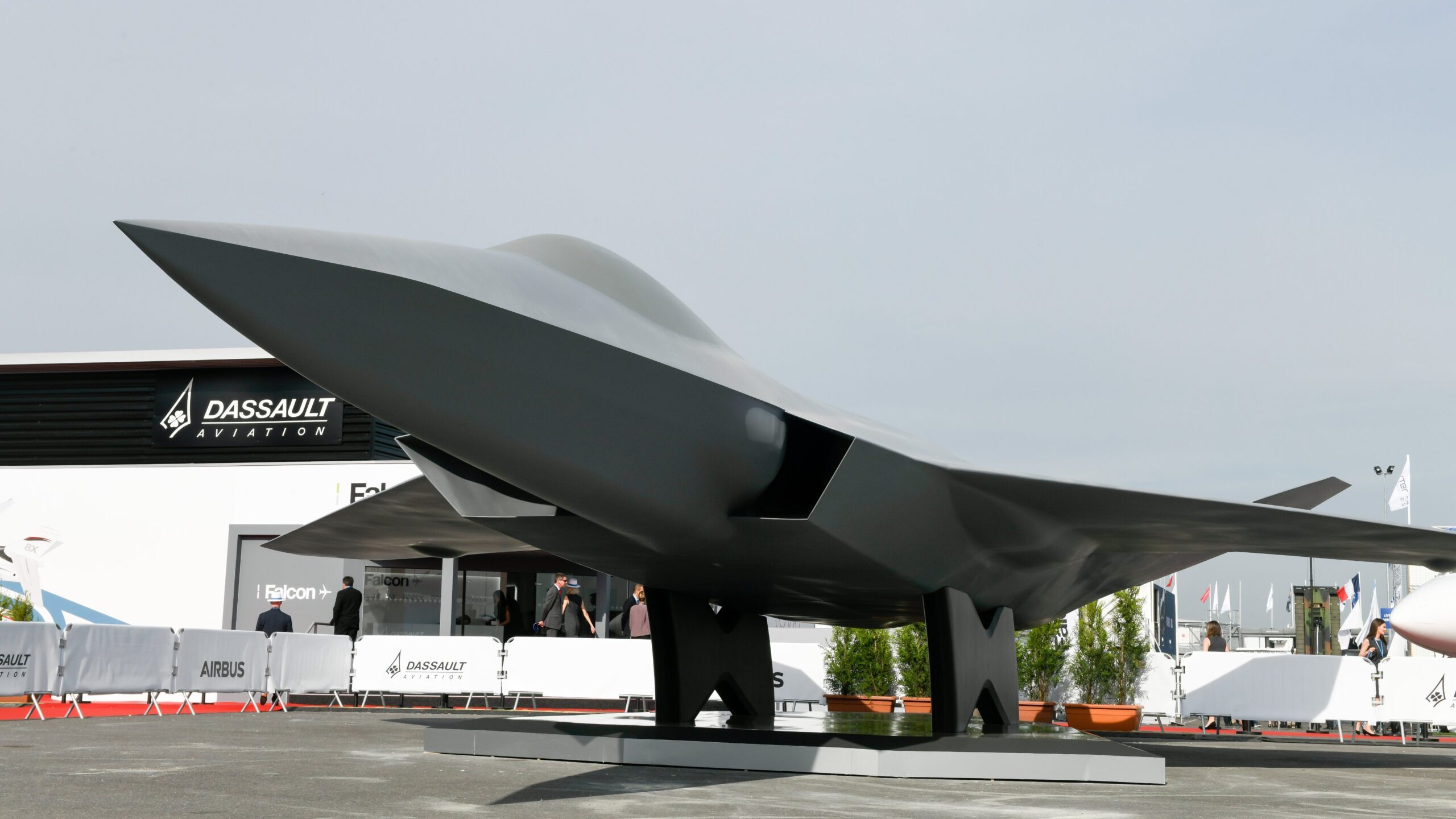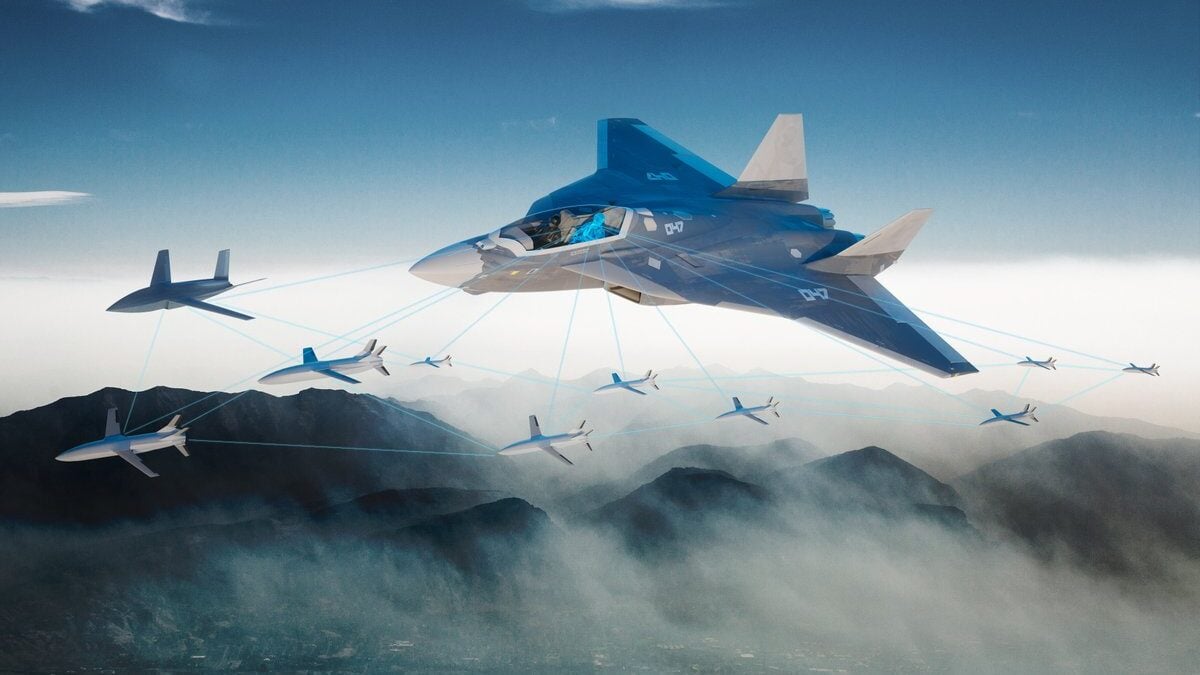
A Future Combat Air System (FCAS) Next Generation Fighter (NGF) mock up on display at the Paris Air Show (Paris Air Show on Twitter)
BELFAST — As Europe looks to deliver two separate sixth generation fighter jets by 2040, confusion has often surrounded such ambition thanks to the somewhat befuddling decision of both teams to refer to their programs as the Future Combat Air System (FCAS). Complicating things further was a December 2022 agreement signed by the UK, Italy and Japan creating the Global Combat Air Programme (GCAP), which is both somehow related and independent to the UK-led FCAS effort.
In an effort to help clear things up, Breaking Defense is happy to offer the following explainer to help our readers — and frankly, our editors — through this morass.
So, the UK is making a new sixth-generation fighter called Tempest, right?
Let’s start with the basics. The UK first signposted an intention to rollout a Future Combat Air System Technology Initiative — technically known as FCAS TI, but largely shortened to just FCAS since — in the 2015 Strategic Defence and Security Review. FCAS was supposed to draw on British industrial technologies which would create a new aircraft or set of “future capabilities” to replace Royal Air Force Eurofighter Typhoons. Even at such an early stage and without any firm requirements set, London decided that it would also focus on an “international by design” approach which would help “define the best partnering construct” capable of developing a sixth-generation aircraft and maximizing export potential, according to the 2018 Combat Air Strategy.
As one UK lawmaker defined it in 2019, “The term Future Combat Air System could refer to a number of international air projects or systems being developed, including the UK programme to replace Typhoon’s capabilities from 2040 onwards.”
In step with the Combat Air Strategy, then-UK defense secretary Gavin Williamson unveiled the Tempest “concept aircraft” at the Farnborough Airshow in 2018, with UK suppliers BAE Systems, Leonardo, MBDA and Rolls-Royce listed as “Team Tempest” partners and supported by the RAF’s Rapid Capabilities Office. At the national level, the UK is teamed with Italy on this effort.
Wait, Tempest and FCAS are different?
Think of it this way: FCAS is the “family of systems” umbrella and includes developing other technologies as well as the design for a future fighter. Tempest is the fighter R&D effort — the UK does not have any standing budget laid out to procure X number of Tempests by Y date. The final product may not even end up being known by that name.
The UK plans on flying a Tempest demonstrator in 2027, and it will help to better understand new fighter jet capabilities. The UK’s eventual next fighter could look an awful lot like Tempest — or the lessons learned could mean a totally new design is the way to go. We won’t truly know for years.
How and why did Italy become involved?
Under a statement of intent agreement in September 2019, Italy signed on to the FCAS effort with British and Italian industry also agreeing to collaborate on the development of a future fighter jet.
The motivation behind Italy joining the UK-led effort was made clear by Italy’s Air Force Chief of Staff Luca Goretti, when he said that Italy could play a bigger role in the project compared to the Franco-German-Spanish FCAS program (we’ll get to that one), according to Reuters.
What about Sweden?
In terms of understanding new partnerships and how they are interconnected, things became more complicated from the moment the UK and Sweden signed a Memorandum of Understanding in July 2019 on a “joint combat air development and acquisition programme” covering “new concepts to meet both nations’ future requirements.” Despite reports subsequently linking Sweden to Tempest, the only partnership to be struck between Stockholm and London relates to FCAS technologies, as opposed to a core fighter jet partnership. Swedish manufacturer Saab has also said it is “on the margins” of FCAS, according to Janes, a sign that industrial activity has cooled considerably.
Ok, so, what is GCAP?
Announced late in 2022, GCAP, which teams the UK, Italy and Japan, has an ultimate aim of delivering a sixth-generation fighter jet by 2035, supported by uncrewed aircraft or loyal wingman combat drones, new weapons and advanced data systems. The fighter jets and supporting aircraft under development will eventually replace UK and Italian Eurofighter Typhoons and Mitsubishi F-2 platforms in the case of Japan.
When will the development phase for GCAP begin?
Launch of a GCAP “core platform concept” will start in 2025, with all partners scheduled to sign a cost-sharing agreement beforehand. The agreement will be based on “joint assessment of costs and national budgets,” according to the UK MoD.
Could new GCAP partners be added in the future?
The UK has said it is “open to exploring how others could become involved to mutual benefit which could include sharing of expertise and development costs.”
Hold on. The UK is working both FCAS and GCAP, and they’re both to develop future fighter capabilities, but they’re different programs?
The main difference is that FCAS will work toward development of a piloted supersonic fighter demonstrator, largely reliant on UK industry and technologies, while GCAP will see UK, Italy and Japan all work to develop and assemble a separate fully operational sixth-generation fighter to meet the combat air requirements of all three nations.
What’s the deal with Japan joining a “European” fighter project?
Despite how odd it might seem that Japan looks to have gate-crashed a European future fighter party with the UK and Italy, Tokyo has been heavily involved in FCAS at an industrial level prior to the signing of GCAP. In that respect, the most high profile collaboration between the UK and Japan was announced in December 2021 when the two parties agreed on a joint future fighter engine demonstrator program, led on the British side by Rolls Royce and BAE Systems and in Japan by Mitsubishi Heavy Industries and IHI.
The benefits to the UK and Italy could be significant as Japan has considerable economic clout to offer as it continues to increase defense spending to counter the threat of China. Tokyo has also been actively experimenting with new stealth jet technologies, having unveiled an X-2 prototype in 2016.
“We had to reach a point by the end of last year (2022) where we had sufficient confidence that there was an alignment of both [UK and Japanese] requirements and potential concept solutions, to know whether we could do a collaborative program together,” said Richard Berthon, Director Future Combat Air at the UK Ministry of Defence, last month.
Hey, wait a minute. I thought France, Germany and Spain are also on FCAS?
Well, they are. It’s just a different FCAS than the UK-led FCAS.
Who thought that was a good idea to use the same name?
Look, we just work here. If it’s helpful, you can refer to it as the Système de combat aérien du futur (SCAF), which they announced at the 2019 Paris Air Show in Le Bourget. In fact, that’s what the French tend to use more these days — although, keeping with the general confusion theme, the Spanish often still default to FCAS. The new fighter jets are to replace French Rafale jets and Eurofighter Typhoons from Germany and Spain.

Concept art of a Next Generation Fighter (NGF) controlling a collection of remote carriers. (Airbus Defence on Twitter)
How is it setup?
SCAF is effectively an umbrella term to cover a Next-Generation Weapon System (NGWS) which itself covers three key areas: a new generation fighter (NGF); Remote Carriers (RC) or adjunct aircraft and an Air Combat Cloud (CC) network capability.
What are the key development stages?
Airbus and Dassault — the two main industry NGF demonstrator contractors — signed a Phase 1B contract in December 2022 opening the way for development of an NGF prototype. The aircraft is scheduled to fly in 2029 for the first time, a two-year delay to an original timeline amid workshare disagreements between Airbus and Dassault. A fully operational NGF has been slated for 2040. Indra leads Spanish industry efforts.
NGF prototype tests are to coincide with a range of other industrial activities including engine, RC, ACC, sensor and low observable demonstrations.
As Breaking Defense previously reported, Phase 1B has a budget of €3.6 billion ($3.8 billion) shared between manufacturers in the three partner countries. An additional contract must also be negotiated within three years to launch phase 2, which covers prototype assembly.
Why has cooperation often looked stressful on this effort?
Historically, joint Franco-German defense programs have been fraught with difficulty and FCAS appears to be following suit. In addition to the usual fights over workshare — major European defense programs are often as much about domestic economic benefits as they are about national security — there is a distinct gulf in future fighter operational requirements between the two. The biggest: nuclear delivery and long range strike missions are at the forefront of French ambitions, but not so for Germany which has consistently had to grapple politically with opposition to equipping aircraft with nuclear weapons and has committed to buying the F-35 for that mission.
Ok, so, wait, who is doing what with whom?
FCAS: UK
Tempest: UK, Italy and Japan
GCAP: UK, Italy and Japan
SCAF: France, Germany and Spain
Wouldn’t it just make more sense from an interoperability standpoint for all these countries, who are either in NATO or are partnered with NATO, to just work together to develop one single jet rather than two opposing ones?
The sound you just heard are the CEOs of all the major European defense firms gasping in horror. Let us never speak of this again.






















